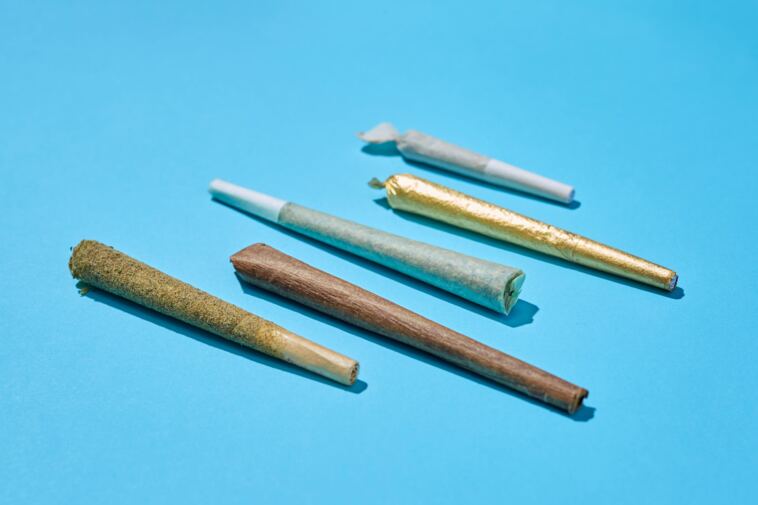- Like
- SHARE
- Digg
- Del
- Tumblr
- VKontakte
- Flattr
- Buffer
- Love This
- Save
- Odnoklassniki
- Meneame
- Blogger
- Amazon
- Yahoo Mail
- Gmail
- AOL
- Newsvine
- HackerNews
- Evernote
- MySpace
- Mail.ru
- Viadeo
- Line
- Comments
- Yummly
- SMS
- Viber
- Telegram
- JOIN
- Skype
- Facebook Messenger
- Kakao
- LiveJournal
- Yammer
- Edgar
- Fintel
- Mix
- Instapaper
- Copy Link
How do you get as high as possible? It’s an age-old question that has consumed weed smokers, growers, researchers, scientists, and anyone who’s ever put some kind bud to their lips since humans first discovered the plant.
Recently, a study came out on the best way to roll a joint and get the highest concentration of cannabinoids. We’ve read, questioned, and tested it to see if there’s any validity to the study’s findings.
What is the best way to roll a joint?
You’d think that reaching certain degrees of high is a numbers game around buying weed with the highest percentage of THC possible — but it’s not. Scientists reported in a study by Scientific American that, with joints, how high you get is largely defined by how the joint was engineered, from how the weed was broken down and rolled to how the joint burns.
 Gina Coleman/Weedmaps
Gina Coleman/WeedmapsThey broke the weed down by different weed particle sizes and hand-rolled the joints to test it. Then, they measured what percentage of cannabinoids reached the end user’s lips and bloodstream. The results alleged that the quality of a joint and getting the most cannabinoids and compounds per puff is about the size of the weed particles after grinding them, the roll quality, and how evenly the final product burns.
The study was headed by Markus Roggen, president and chief science officer of Delic Labs, a cannabis and psilocybin research facility in Vancouver, British Columbia. Roggen and his colleagues questioned whether cannabinoid concentration was the most important factor in determining cannabis’s intoxicating effects and what other factors contribute to an enjoyable experience.
The team of scientists crafted a study where a smoke machine puffed on three pre-rolled paper cones in the same capacity and then measured the volume of cannabis compounds that were delivered. They used a coffee grinder and sieve to grind the cannabis and then hand-rolled the joints. The samples had weed particles that were one millimeter, three millimeters, and five millimeters in diameter.
 Gina Coleman/Weedmaps
Gina Coleman/WeedmapsThey made joints from half-gram samples of each and used a “smoke cycle simulator” that inhaled six times for three seconds before exhaling. Filters collected the aerosols at the machine’s 3D-printed mouthpiece, and the researchers used analytical chemistry techniques to measure aerosol levels from puffs taken at the beginning, middle, and end of each joint.
How did we roll the “best” joints possible?
I used this chart to determine what kind of sieve to purchase to get the particle size right. Then I hit Amazon for the cops:
- 1mm: No. 18 mesh using this sieve
- 3mm (2.83mm): No. 7 mesh using this sieve
- 5mm (4.76mm): No. 4 mesh using this sieve
Note: smoking by particle size requires way too much work, and I know you aren’t going to put that effort in. But we did, ya know, for science. However, human trial and error greatly affects variable results in this experiment.
Before testing, I knew the best time to smoke would be in the morning while I was completely sober, so I spaced the samples out between Tuesday, Wednesday, and Thursday mornings. The original study agreed that a human volunteer could not assess this many samples back-to-back with accurate results.
Step 1
I used a red Solo cup and a basic kitchen scale to weigh 0.5-gram samples of LA Cherry Runtz from Flight Path. I rubbed them against the sieves to break down the weed.
Step 2
I hand-rolled the samples into 1.4-inch OCB Virgin Cones.
Step 3
I inhaled.
During the smoke, I hit each joint six times for three “Mississippis” — the true way to count seconds, just as the study suggested. I jotted my journey over the following three hours to remember and compare the feelings.
Results
Ultimately, I know what you’re wondering: Could I really tell the difference between the highs based on particle size? Unfortunately, no, I could not. I just got high like any other time I’ve smoked a lil’ half-grammer.
When using different sieves for different particle sizes, I did not detect a higher high between a joint rolled with 1mm and 5mm particles. Perhaps some sort of monitor would have suggested differently, but if we’re going off of a human test and human feelings, it simply wasn’t there.
What does this study mean for the future of joints?
As of right now, nothing. Weed companies are not about to start marketing products based on particle size in a world where they are still fighting the THC percentage and indica vs sativa vs hybrid battles. But the information is still nice to know.
 Gina Coleman/Weedmaps
Gina Coleman/WeedmapsAmber Wise, scientific director of the cannabis testing lab Medicine Creek Analytics, said, “Roggen’s data supports the argument that THC percentage matters less than particle size, and pre-roll manufacturers will find this useful.” According to Scientific American, the study concluded that further progress would require addressing variability that persisted in the team’s measurements — even between identically prepared joints.
In future work, Roggen and his colleagues plan to examine how other factors, including humidity, combustion source, and packing density, influence a joint’s architecture and effects. We’ll be around to test those findings, too.
